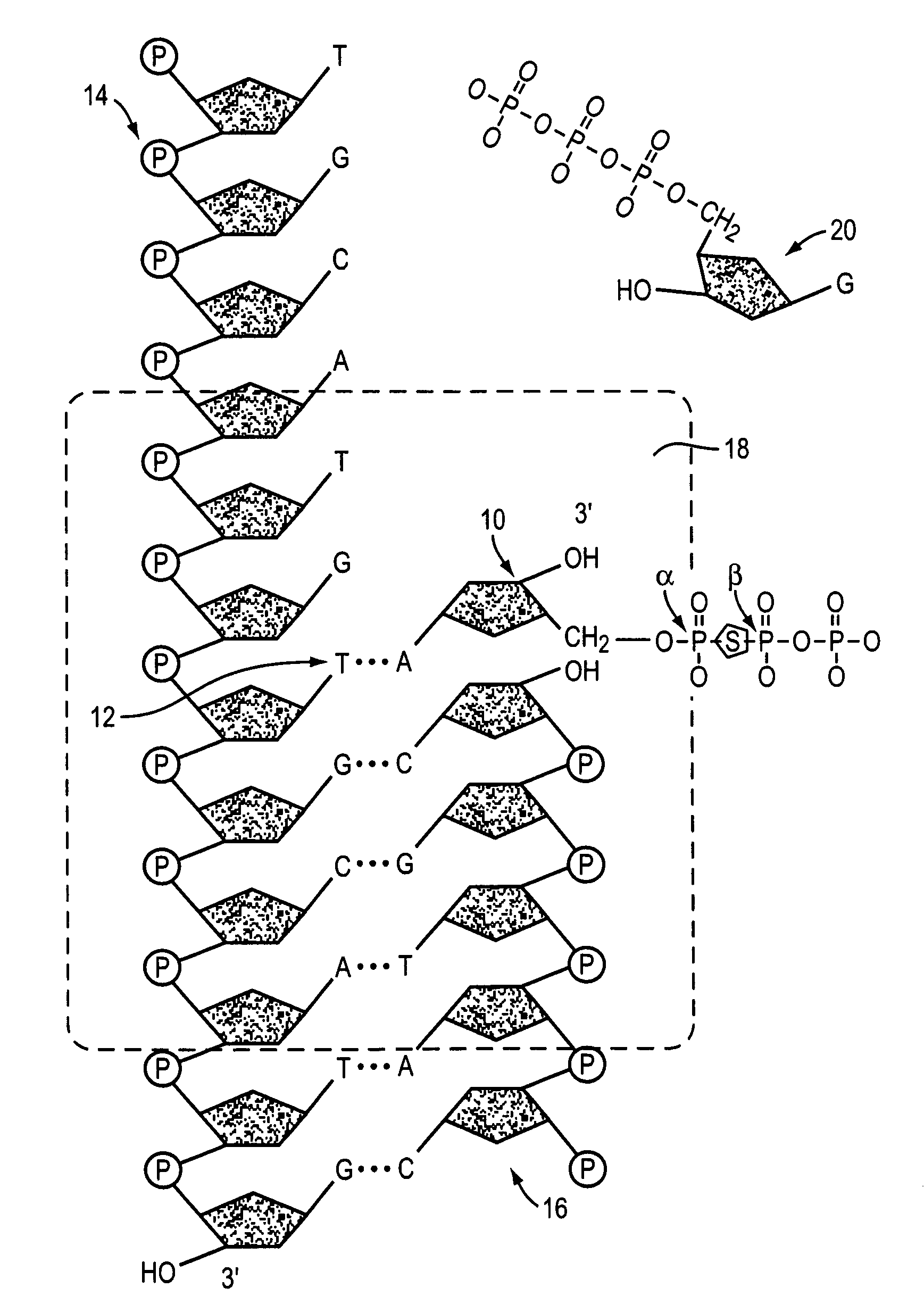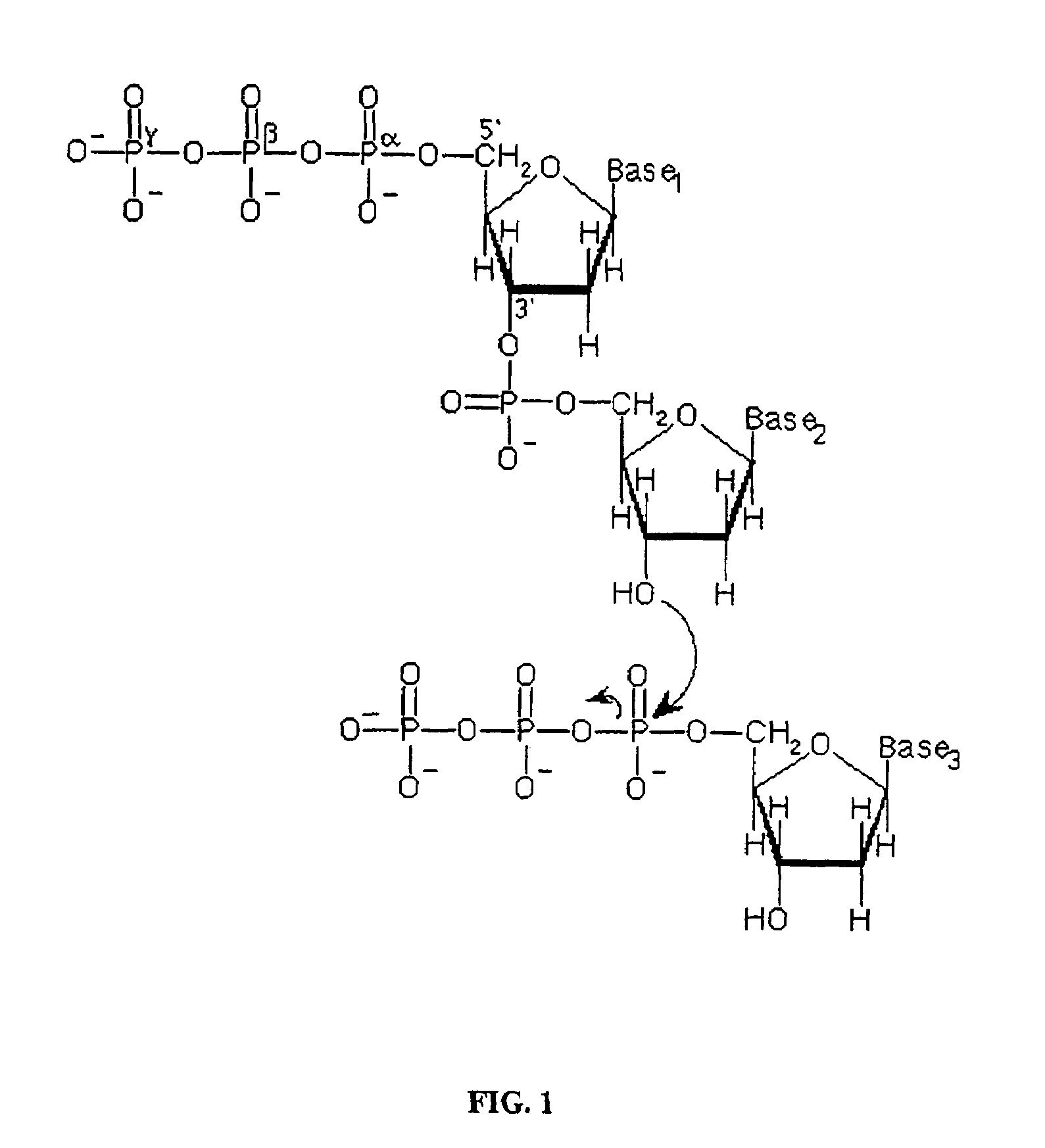Methods and compositions for improving fidelity in a nucleic acid synthesis reaction
a nucleic acid synthesis and fidelity technology, applied in the field of methods for improving fidelity in can solve the problems of still an identifiable rate of misincorporation, reduced efficiency of unconventional nucleotides, and reduced efficiency of incorporating nucleotides. the effect of improving the fidelity of the nucleic acid synthesis reaction
- Summary
- Abstract
- Description
- Claims
- Application Information
AI Technical Summary
Benefits of technology
Problems solved by technology
Method used
Image
Examples
example 1
Single Molecule Sequencing Using Nucleotide Derivatives
[0034]The following nucleotide derivatives, each comprising a substitution of the oxygen molecule bridging the α and β phosphate groups with a sulfur molecule, are prepared: α,β-S-2′-deoxyadenosine 5′-triphosphate; α,β-S-2′-deoxycytidine 5′-triphosphate; α,β-S-2′-deoxyguanosine 5′-triphosphate; and α,β-S-2′-deoxythymidine 5′-triphosphate. Primer / template duplexes are bound to a solid support in a concentration that results in individually optically resolvable duplexes. The bound duplexes are subjected to serial sequencing-by-synthesis cycles in which a polymerase, labeled standard nucleotide, and nucleotide derivatives corresponding to each of the three non-standard nucleotide species are combined. The incorporation of a labeled nucleotide is determined, recorded and the reaction serially repeated with labeled nucleotide corresponding to each of the different nucleotide species and the appropriate nucleotide derivatives in order...
example 2
Assay for the Inhibition of Polymerase Activity
[0035]A simple assay may be performed to assess the ability of a usefulness of nucleotide derivative in methods and compositions of the invention.
[0036]Primed DNA template is diluted into an appropriate volume of 20 mM Tris-HCl, pH 7.5 and the enzyme is diluted into an appropriate volume of 20 mM Tris-HCl, containing 2 mM β-mercaptoethanol, and 100 mM KCl. 0.05 mg / mL primed DNA template and 0.01 U / μL DNA polymerase are pipetted into microcentrifuge tubes or a 96-well plate in a 50 μL reaction volume. 1.6 μM nucleotide derivative is added to the test reactions. Blank reactions excluding enzyme and control reactions excluding test compound are also prepared using enzyme dilution buffer and test compound solvent, respectively. The reaction is initiated with reaction buffer with the following components 20 mM Tris-HCl, pH 7.5; 200 μg / mL bovine serum albumin; 100 mM KCl; 2 mM β-mercaptoethanol; 10 mM MgCl2, 1.6 μM dATP, dGTP, dCTP, and dTTP;...
PUM
| Property | Measurement | Unit |
|---|---|---|
| volume | aaaaa | aaaaa |
| pH | aaaaa | aaaaa |
| pH | aaaaa | aaaaa |
Abstract
Description
Claims
Application Information
 Login to View More
Login to View More - R&D
- Intellectual Property
- Life Sciences
- Materials
- Tech Scout
- Unparalleled Data Quality
- Higher Quality Content
- 60% Fewer Hallucinations
Browse by: Latest US Patents, China's latest patents, Technical Efficacy Thesaurus, Application Domain, Technology Topic, Popular Technical Reports.
© 2025 PatSnap. All rights reserved.Legal|Privacy policy|Modern Slavery Act Transparency Statement|Sitemap|About US| Contact US: help@patsnap.com



